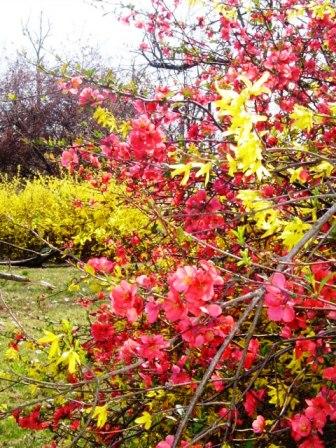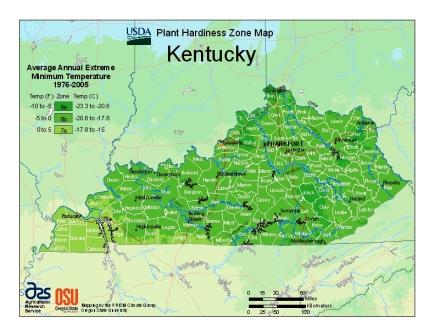(Clinton KY, March 20, 2012) Welcome to Spring 2012!
The first day of spring comes with balmy winds, sunny skies and shorts inducing temperatures. The string of warm weather has local greybeards shaking their heads. Farm equipment seems to be everywhere. John Deere green and Kubota orange are the trendy colors in this end of Kentucky.
Jackson Purchase gardeners have suspected for some time that the growing season is not what it was in grandpa’s day. Temperatures in the waning weeks of winter hover between 65 and 80 degrees. Bees are buzzing and pests like mosquitoes and flies are making their appearance. Air conditioners are cranked up. Allergy sufferers didn’t get much of a respite this year. Pollen from blooming trees and flowers are making their lives miserable.
In January 2012, the US Department of Agriculture confirmed suspicions that temps are warmer when the new “Plant Hardiness” zones were released. The Jackson Purchase, from Paducah to Fulton to the Lakes joined northwest Tennessee in a zone change. Where once the area was listed as 6B (temperatures dipping to -10 to -15 degrees), the area is now listed as 7A. Based upon the most recent thirty years of record keeping, temperatures are not expected to dip below zero.
Lest that revered old bastion of conservatism, known as the USDA, be accused of buying into all this talk of global warming, the website is quick to point out:
“…Climate changes are usually based on trends in overall average temperatures recorded over 50-100 years. Because the USDA PHZM represents 30-year averages of what are essentially extreme weather events (the coldest temperature of the year), changes in zones are not reliable evidence of whether there has been global warming.
Compared with the 1990 version, zone boundaries in this edition of the map have shifted in many areas. The new PHZM is generally one half-zone warmer than the previous PHZM throughout much of the United States, as a result of a more recent averaging period (1974–1986 vs. 1976–2005).
However, some of the changes in the zones are the results of the new, more sophisticated mapping methods and greater numbers of station observations used in this map, which has greatly improved accuracy, especially in mountainous regions. These changes are sometimes to a cooler, rather than warmer, zone…” USDA Plant Hardiness website
The result of the zone change is seeing more exotic plants showing up in greenhouses and at the big box stores. Cacti lived through the winter. Rose bushes are setting buds. Vegetable gardens are tilled and ready for more warm weather selections than cabbage and lettuce. The deadline for early peas passed weeks ago.
What does this mean for agriculture in the Purchase?
 It can be very good news. It can be very good news.
Longer growing seasons could mean more crops in the field and more money in farmers’ pockets. That in turn puts more money in local merchants’ hands. That’s just the ticket in a sagging economy.
It can be very bad news.
If the winter cold was not long enough or cold enough to kill off the varmints (see flies and mosquitoes mentioned above) then they are around in greater numbers. Eliminating pests means more pesticides, which is not good for the environment. Not eliminating them has health risks. Mosquitoes carry West Nile fever and other diseases. Ticks carry Lyme disease, a particularly insidious and debilitating affliction.
As the USDA pointed out, climate predictions are an average. The new zone does not mean there is no risk of low temperatures in April and May. A few years ago, a cold snap in April killed trees and plants that had jumped the season because of warm days in February. Snow in late April and early May is unusual, but not beyond the realm of possibility.
Warm air from the south meeting cold air from the north creates the storms and tornadoes of spring. This year, tornadoes have already struck areas in the Midwest that, in the past, would have snow storms. A change in zone could mean a change in extreme weather patterns.
The new zone is no news to Mother Nature. It remains to be seen what she will have in store for us this spring. Good. Bad. Or indifferent. If you don’t like Kentucky weather, wait a minute. It will change.
|



 It can be very good news.
It can be very good news.



